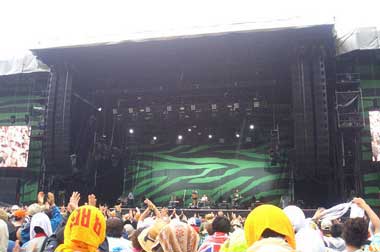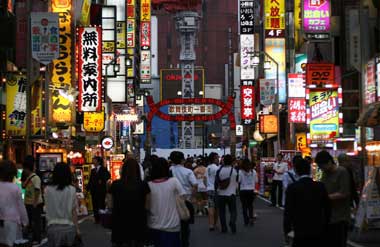Dancing neon lights sway to the beat of legendary tunes as an explosion of music drive hurdles of supergroupies, hippies and hedonists into a frenzy in the in the loudest, largest, craziest and most iconic music festival in Japan - Fuji Rock Festival.
Set in a mystifying location in the mountains of Naeba, to get some stages in the Fuji Rock Festival you have to trek through the forest or take a gondola. No wonder the event attracts all sorts of festival-goers, ranging from hardcore rock fans to ecstasy-addicts, festival enthusiasts and nature lovers.
The latter will specially enjoy the opportunities to exercise among the hillsides via atmospheric boardwalks through the forest, past sparkling streams, villages or hammocks and organic food stalls. An hour's walk from the site entrance, you'll come across the hippy hangout "Stoned Circle" where you can play ramshackle instruments and drums. Get on the Dragondola - the longest gondola lift in the world - as it takes you to the top of the mountain which overlooks the festival site.
The centre of the site is called Oasis, where you'll be able to choose from over 30 stalls offering food from around the world. Even though the main site closes each night after the final act, Oasis remains open until late at night, as well as the Red Marquee where you can join a rave till dawn.
The party starts the day before the official festival featuring bon-odori - traditional Japanese folk dance), prize draws, food stalls and a fireworks display. There are seven main stages and other minor stages scattered throughout the site. The main stage - Green stage - has a capacity for almost 50,000 spectators.
This four-day music festival is organised by Smash Japan and features more than 200 Japanese and international musicians. Every summer the event attracts up to a hundred thousands to the festival grounds and has a year-on-year crackling lineup.
Some of the headliners and performers have been The Stone Roses, Radiohead, Heady Eye, Elvis Costello and The Imposters, Coldplay, Arctic Monkeys, Tokyo Ska Paradise, The Faces, The Chemical Brothers, The Faces, Muse, Vampire Weekend, Jamie Cullum, Oasis, Franz Ferdinand, Paul Weller, Weezer, Kiyoshiro Imawano Special Message Orchestra, among others.
If you want to stay at a hotel, it is recommend to book one a year ahead. Otherwise, make sure you bring a distinctive tent and enjoy the unique camping experience. If you feel like relaxing watching a movie, there's an outdoor cinema by the river - now picture how wonderful it is to watch a film in that setting. Don't miss out on the opportunity to have udon noodles for breakfast.




